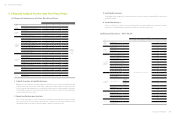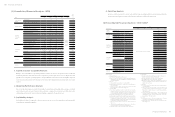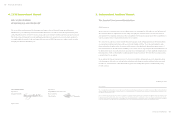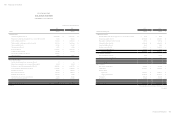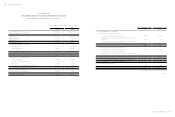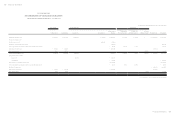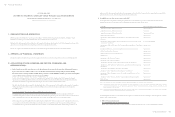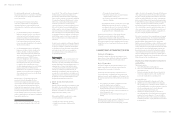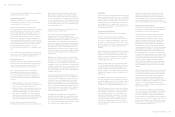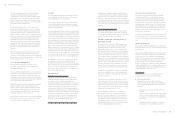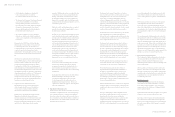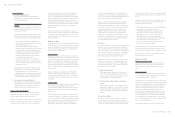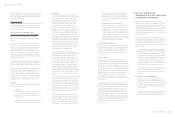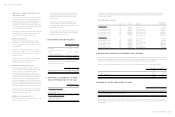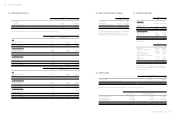HTC 2015 Annual Report Download - page 100
Download and view the complete annual report
Please find page 100 of the 2015 HTC annual report below. You can navigate through the pages in the report by either clicking on the pages listed below, or by using the keyword search tool below to find specific information within the annual report.Financial information
Financial information
196
197
Inventories
Inventories consist of raw materials, finished goods and work-
in-process and are stated at the lower of cost or net realizable
value. Inventory write-downs are made by item, except where
it may be appropriate to group similar or related items. Net
realizable value is the estimated selling price of inventories
less all estimated costs of completion and costs necessary to
make the sale. Inventories are recorded at weighted-average
cost on the balance sheet date.
Investments in Subsidiaries
Subsidiaries are the entities controlled by the Company.
Under the equity method, the investment is initially
recognized at cost and the carrying amount is increased or
decreased to recognize the Company's share of the profit or
loss and other comprehensive income of the subsidiary after
the date of acquisition. Besides, the Company also recognizes
the Company's share of the change in other equity of the
subsidiary.
Changes in the Company's ownership interests in subsidiaries
that do not result in the Company's loss of control over the
subsidiaries are accounted for as equity transactions. Any
difference between the carrying amounts of the investment
and the fair value of the consideration paid or received is
recognized directly in equity.
When the Company's share of losses of a subsidiary equals
or exceeds its interest in that subsidiary (which includes any
carrying amount of the investment in subsidiary accounted
for by the equity method and long-term interests that, in
substance, form part of the Company's net investment in the
subsidiary), the Company continues recognizing its share of
further losses.
The acquisition cost in excess of the acquisition-date fair
value of the identifiable net assets acquired is recognized as
goodwill. Goodwill is not amortized. The acquisition-date fair
value of the net identifiable assets acquired in excess of the
acquisition cost is recognized immediately in profit or loss.
When the Company ceases to have control over a subsidiary,
any retained investment is measured at fair value at that date
and the difference between the previous carrying amount
of the subsidiary attributable to the retained interest and
its fair value is included in the determination of the gain or
loss. Furthermore, the Company accounts for all amounts
previously recognized in other comprehensive income in
relation to that subsidiary on the same basis as would be
required if the Company had directly disposed of the related
assets or liabilities.
Profits and losses from downstream transactions with a
subsidiary are eliminated in full. Profits and losses from
upstream with a subsidiary and sidestream transactions
between subsidiaries are recognized in the Company' parent
company only financial statements only to the extent of
interests in the subsidiary that are not related to the Company.
Investments in Joint Ventures
Joint venture is a joint arrangement whereby the Company
and other parties that have joint control of the arrangement
have rights to the net assets of the arrangement.
When the Company subscribes for additional new shares
of the joint venture at a percentage different from its
existing ownership percentage, the resulting carrying
amount of the investment differs from the amount of the
Company's proportionate interest in the joint venture.
The Company records such a difference as an adjustment
to investments accounted for by the equity method, with a
corresponding amount charged or credited to capital surplus.
If the Company's ownership interest is reduced due to the
additional subscription of the new shares of joint venture,
the proportionate amount of the gains or losses previously
recognized in other comprehensive income in relation to that
joint venture is reclassified to profit or loss on the same basis
as would be required if the investee had directly disposed
of the related assets or liabilities. When the adjustment
should be debited to capital surplus, but the capital surplus
recognized from investments accounted for by the equity
method is insufficient, the shortage is debited to retained
earnings.
When the Company's share of losses of a joint venture equals
or exceeds its interest in that joint venture (which includes
any carrying amount of the investment accounted for by the
equity method and long-term interests that, in substance,
form part of the Company's net investment in the joint
venture), the Company discontinues recognizing its share of
further losses. Additional losses and liabilities are recognized
only to the extent that the Company has incurred legal
obligations, or constructive obligations, or made payments on
behalf of that joint venture.
Any excess of the cost of acquisition over the Company's
share of the net fair value of the identifiable assets, liabilities
and contingent liabilities of a joint venture recognized at
the date of acquisition is recognized as goodwill, which is
included within the carrying amount of the investment and is
not amortized. Any excess of the Company's share of the net
fair value of the identifiable assets, liabilities and contingent
liabilities over the cost of acquisition, after reassessment, is
recognized immediately in profit or loss.
Aforementioned assets and liabilities that are not classified as
current are classified as non-current.
Business Combinations
Acquisitions of businesses are accounted for using the
acquisition method. Acquisition-related costs are generally
recognized in profit or loss as incurred.
Goodwill is measured as the excess of the sum of the
consideration transferred, the amount of any non-controlling
interests in the acquiree, and the fair value of the acquirer's
previously held equity interest in the acquiree over the net
of the acquisition-date amounts of the identifiable assets
acquired and the liabilities assumed. If, after re-assessment,
the net of the acquisition-date amounts of the identifiable
assets acquired and liabilities assumed exceeds the sum of the
consideration transferred, the amount of any non-controlling
interests in the acquiree and the fair value of the acquirer's
previously held interest in the acquiree, the excess is
recognized immediately in profit or loss as a bargain purchase
gain.
Non-controlling interests are initially measured either at fair
value or at the non-controlling interests' proportionate share
of the fair value of the acquiree's identifiable net assets.
Foreign Currencies
In preparing the parent company only financial statements,
transactions in currencies other than the entity's functional
currency (foreign currencies) are recognized at the rates of
exchange prevailing at the dates of the transactions.
At the end of each reporting period, monetary items
denominated in foreign currencies are retranslated at
the rates prevailing at that date. Exchange differences on
monetary items arising from settlement or translation are
recognized in profit or loss in the period in which they arise
except for:
a. Exchange differences on transactions entered into in
order to hedge certain foreign currency risks (please refer
to Note 4 Hedge accounting section); and
b. Exchange differences on monetary items receivable from
or payable to a foreign operation for which settlement
is neither planned nor likely to occur in the foreseeable
future (therefore forming part of the net investment in
the foreign operation), which are recognized initially in
other comprehensive income and reclassified from equity
to profit or loss on disposal of the net investments.
Non-monetary items measured at fair value that are
denominated in foreign currencies are retranslated at the rates
prevailing at the date when the fair value was determined.
Exchange differences arising on the retranslation of non-
monetary items are included in profit or loss for the period
except for exchange differences arising from the retranslation
of non-monetary items in respect of which gains and losses are
recognized directly in other comprehensive income, in which
case, the exchange differences are also recognized directly in
other comprehensive income.
Non-monetary items that are measured at historical cost in a
foreign currency are not retranslated.
For the purposes of presenting the parent company only
financial statements, the assets and liabilities of the
Company's foreign operations are translated into New Taiwan
dollars using exchange rates prevailing at the end of each
reporting period. Income and expense items are translated
at the average exchange rates for the period, unless exchange
rates fluctuate significantly during that period, in which case
the exchange rates at the dates of the transactions are used.
Exchange differences arising, if any, are recognized in other
comprehensive income and accumulated in equity (attributed
to the owners of the Company and non-controlling interests
as appropriate).
On the disposal of a foreign operation (i.e. a disposal of the
Company's entire interest in a foreign operation, or a disposal
involving loss of control over a subsidiary that includes a
foreign operation, or a partial disposal of an interest in a joint
arrangement or an associate that includes a foreign operation
of which the retained interest becomes a financial asset), all of
the exchange differences accumulated in equity in respect of
that operation attributable to the owners of the Company are
reclassified to profit or loss.
In relation to a partial disposal of a subsidiary that does not
result in the Company losing control over the subsidiary, the
proportionate share of accumulated exchange differences is
re-attributed to non-controlling interests of the subsidiary
and is not recognized in profit or loss. For all other partial
disposals (i.e. partial disposals of associates or jointly ventures
that do not result in the Company losing significant influence
or joint control), the proportionate share of the accumulated
exchange differences recognized in other comprehensive
income is reclassified to profit or loss.
Goodwill and fair value adjustments on identifiable assets
and liabilities acquired arising on the acquisition of a foreign
operation are treated as assets and liabilities of the foreign
operation and translated at the rate of exchange prevailing at
the end of each reporting period. Exchange differences arising
are recognized in other comprehensive income.



